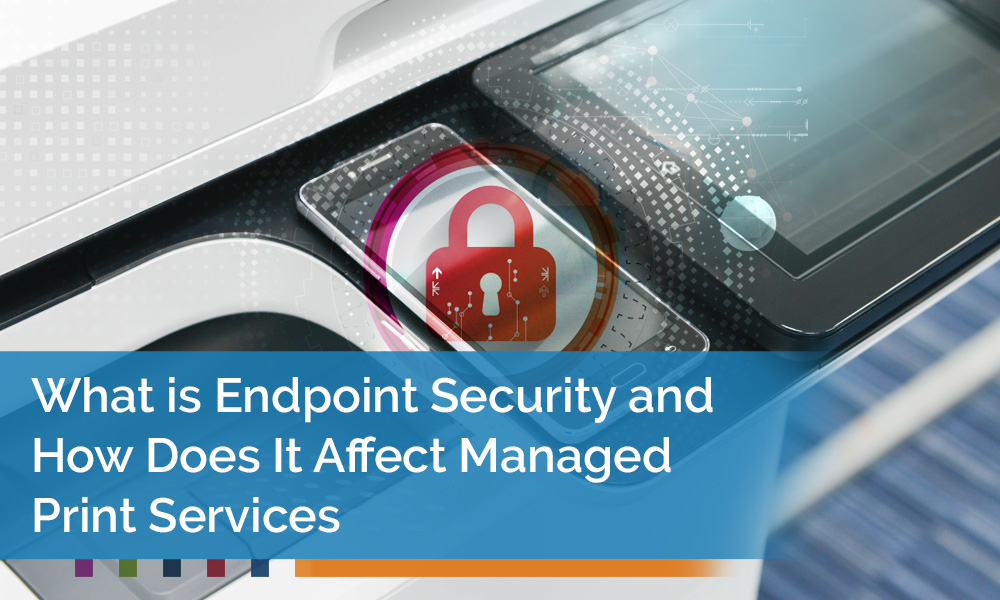Endpoint security involves securing all devices that access a company’s network to protect against unauthorized use and data loss. It is particularly crucial for a company’s managed print services (MPS), as printers represent an increasing risk to network security.
Today’s smart network printers can be an entry point for unauthorized users with malicious intent. According to a Spiceworks survey, a printer today is 68% more likely to the source of an external data breach than it was just a few years ago; it’s 118% more likely to be the source of an internal breach. This makes endpoint security as essential for network printers as it is for laptops and other types of user devices.
Understanding Endpoint Security
Endpoint security is a way of protecting a company’s network by monitoring and securing all endpoints to the network – computers, workstations, tablets, phones, and other devices, including printers. Security teams use a central technology platform to ensure that bad actors don’t hijack endpoints to gain unauthorized network access or plant ransomware and other malware.
This security is typically centrally managed, although some endpoint security software may be installed on individual devices. It may include anti-malware protection, web filtering, data encryption, access control, endpoint scanning, and other similar technologies.
Why Endpoint Security is Important
In years past, most security breaches were through the network. Increasingly, however, breaches are happening through the growing number of endpoints. According to the 2019 Endpoint Security Trends Report, 70% of data breaches originate at an endpoint.
To stop unauthorized access via all these various endpoints, enterprises must employ robust endpoint security. At any given point in time, however, 42% of enterprise endpoints are unprotected, which represents an attractive opportunity for malicious actors.
Best Practices for Endpoint Security
Employing endpoint security is dependent on an organization’s specific needs for network manageability, flexibility, and security – as well as the number and variety of endpoints attached to the network. In general, companies should adhere to the following best practices in designing an endpoint security plan.
Access Control
It the past, it was unfortunately common for common users to possess administrator-level credentials. This enabled just about anyone to access an organization’s sensitive data – and also enabled malicious actors to breach that data or install malware from those common user accounts. Least privilege access limits access essential data or functions to only those users who need it. For example, under the old rules, any user might be able to install new software on the system; with least privilege access, most users would not have this privilege.
Endpoint Scanning
Continuous scanning of all endpoints is essential for strong endpoint security. Scans should be automatically initiated when media is inserted in local drives, when USB devices are connected, and when new endpoints are connected to the system. Continuous memory monitoring is also essential to guard against unauthorizing running processes and malicious rootkits. These scans should be analyzed by next-generation endpoint security platforms and capable of being monitored in real-time.
Application Control
The endpoint security system should limit the number of users, especially remote users, who can install and execute applications. Creating a whitelist of executable files will also reduce the risk of malware infection.
Location Awareness
Security levels should be established by the user and the device’s location. For example, a work laptop might have a different security level when connecting in the office, inside the firewall, then when connecting remotely from the user’s home or via a VPN.
Disk Encryption
If at all possible, every hard disk on every connected device should be encrypted. This protects against data theft if the device is lost or stolen.
Endpoint Security for Managed Print Services
Multifunction printers are endpoints that represent a particular security risk. If not properly protected, printers can provide easy access to enterprise networks and servers. For this reason, printers need the same type of endpoint security as other types of devices.
This endpoint security can be employed as part of an organization’s managed print services. Printers must be treated in the same manner as computers and other types of network endpoints. Note the following best practices.
Access Control
Printer access should be limited to approved users only. Approved printers should be whitelisted, and unauthorized devices denied access to the network.
Endpoint Scanning
All printer use should be monitored, and staff alerted when suspicious activity occurs. The activity of different printers should be compared to anomalous behavior.
Data Encryption
Data sent from users to each printer should be encrypted to prevent hijacking or unauthorized access.
Turn to James Imaging for Your Company’s Managed Print Services
James Imaging Systems has been providing managed print services to Wisconsin businesses for more than 40 years. We provide a wide variety of print management strategies that employ robust endpoint security – and help your business reduce costs and boost productivity.
Contact James Imaging Systems today to learn more about secure managed print services!


